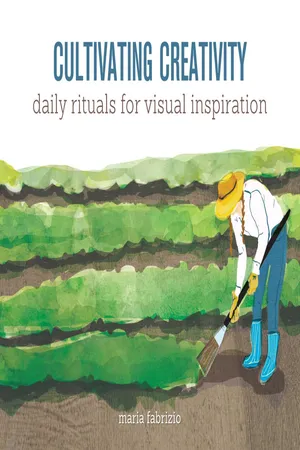
- 140 pages
- English
- ePUB (mobile friendly)
- Available on iOS & Android
eBook - ePub
About this book
"Creative longevity is about what you do to prepare yourself for the ripe moment, when the potential of an idea is able to grow into something useful.... This book is for anyone who has a tendency to think visually and needs to satisfy their creative soul." --from the Introduction
Discover the road to productivity and success by keeping your creative juices flowing daily. Cultivating Creativity is a book based on the idea that creativity requires ample momentum--if you stop, you'll stall. In order to get the creative inspiration you need to do your design work well, it's important to establish daily creative routines.
Author Maria Fabrizio has compiled here a beautiful and inspirational guide, a companion to unlocking your creativity every day. Create every day, and you'll be able to keep creating every day--it's as simple as that.
Discover the road to productivity and success by keeping your creative juices flowing daily. Cultivating Creativity is a book based on the idea that creativity requires ample momentum--if you stop, you'll stall. In order to get the creative inspiration you need to do your design work well, it's important to establish daily creative routines.
Author Maria Fabrizio has compiled here a beautiful and inspirational guide, a companion to unlocking your creativity every day. Create every day, and you'll be able to keep creating every day--it's as simple as that.
Frequently asked questions
Yes, you can cancel anytime from the Subscription tab in your account settings on the Perlego website. Your subscription will stay active until the end of your current billing period. Learn how to cancel your subscription.
At the moment all of our mobile-responsive ePub books are available to download via the app. Most of our PDFs are also available to download and we're working on making the final remaining ones downloadable now. Learn more here.
Perlego offers two plans: Essential and Complete
- Essential is ideal for learners and professionals who enjoy exploring a wide range of subjects. Access the Essential Library with 800,000+ trusted titles and best-sellers across business, personal growth, and the humanities. Includes unlimited reading time and Standard Read Aloud voice.
- Complete: Perfect for advanced learners and researchers needing full, unrestricted access. Unlock 1.4M+ books across hundreds of subjects, including academic and specialized titles. The Complete Plan also includes advanced features like Premium Read Aloud and Research Assistant.
We are an online textbook subscription service, where you can get access to an entire online library for less than the price of a single book per month. With over 1 million books across 1000+ topics, we’ve got you covered! Learn more here.
Look out for the read-aloud symbol on your next book to see if you can listen to it. The read-aloud tool reads text aloud for you, highlighting the text as it is being read. You can pause it, speed it up and slow it down. Learn more here.
Yes! You can use the Perlego app on both iOS or Android devices to read anytime, anywhere — even offline. Perfect for commutes or when you’re on the go.
Please note we cannot support devices running on iOS 13 and Android 7 or earlier. Learn more about using the app.
Please note we cannot support devices running on iOS 13 and Android 7 or earlier. Learn more about using the app.
Yes, you can access Cultivating Creativity by Maria Fabrizio in PDF and/or ePUB format, as well as other popular books in Art & Art General. We have over one million books available in our catalogue for you to explore.
Information
Topic
ArtSubtopic
Art GeneralPART I:
ritual
I’M NOT ALLOWED TO CALL MY GRANDPARENTS BEFORE 10:00 A.M. They very rarely ask for anything or have limitations on visiting, but they would prefer that a doorbell didn’t ring or a grandchild didn’t stop by before the breakfast table has been cleared.
They follow their retirement clock and enjoy waking slowly with no rush. They are set in their quiet morning ritual. If I had to guess, I’d bet part of their ritual includes watching birds in the yard and plotting against squirrels who are eating from their pecan trees. I’m sure they take a considerable amount of time watching the weather so that they can anticipate when it will be best to tend to their garden. While their teeth brushing, dressing, eating and waking routine might be consistent, the gardener’s full-day ritual depends on Mother Nature. I suspect that part of the reason my grandparents ask for peace before 10:00 A.M. in the summer is so that they can make their way to the yard and do small tasks before the heat becomes unbearable.
They also have an evening ritual in the summer. Sometimes I forget their post-dinner duties and call. The phone will ring and I’ll hear my grandmother’s voice on the machine and worry for a second, but then I remember that they’ve gone into the yard. While the cicadas sing and the frogs chirp, they work through twilight until the little solar lights come on along the path, and then they go inside to rest.
Caring for and creating their yard and garden informs their routine. They work when it feels best, when it is most efficient and when they can feel satisfied at the end of the day.
CHAPTER ONE
field notes
MY PASSION FOR WATCHING THE MOON sink into the first light from the sun is born from somewhere deep in my childhood. My parents’ routine surely shaped my natural alarm clock. My father has been a morning person for as long as I can remember. He wakes up around 5:00 A.M., throws back a cup of tar-black coffee and descends the stairs to the basement where he lifts weights and listens to talk radio for an hour. My mother isn’t a morning person anymore, but when she was a mail carrier she was sorting thousands of letters at the post office before most people had the chance to linger in bed after their alarm went off.
It was difficult to be an instinctively early riser as a child. I was always wide-eyed and fidgety by 7:00 A.M. at a sleepover. Among the piles of blankets, sleeping bags and junk food, I’d wonder why I couldn’t just continue to dream like all the other girls sprawled about the living room floor. I used to feel self-conscious about my bird-like habit, but I’ve found a way to harness that restlessness and make use of the time when my mind is most active.

When I was a teenager, I started to wake early on Saturday mornings and wait for 6:00 A.M. so that I could legally escape the dormitory where I lived for the last two years of high school. I went to a public residential arts school a few hours away from my home. However, some weekends I hung around campus instead of begging my parents to drive me back and forth. Saturday mornings were the best time to quietly crunch my way through a bowl of Cheerios and sneak up to the studios. My desire to be alone making art surely didn’t come from a place of discipline; it came from angsty teenage emotions. I didn’t make anything profound or beautiful on those mornings, but I’d leave the empty hallways feeling like I had a secret. I could enjoy the rest of my day because I had a sense that I had accomplished something. The act of creating—no matter what the outcome of the project—left me with a feeling of completeness and simple satisfaction.
About two years ago, I started to notice that my creativity plummeted around 3:00 P.M. It really didn’t matter if I was writing an email, grading a paper or trying to sketch—my brain was about as organized as the floor of my closet. I wasn’t making decisions as confidently as I would during the coffee-brewing hours. Every “afternoon idea” was garbage. I decided I should track when I felt most creative and keep a tiny creative process diary. After several weeks of taking field notes about the conditions under which I worked best, I saw that my peak happiness time was between 5:30 A.M. and noon. If I could accomplish something in that time, I felt like I was sliding down a rainbow into a bowl of cotton candy. So, I adjusted my schedule and allowed my day to be more morning and less afternoon.
First, I decided that I could go to bed earlier and get up earlier since I was naturally already an early riser, I felt that I could adjust to even earlier. I turn off my email from 5:00 A.M. to 9:00 A.M. When the world is sleeping and there are no ringing phones or email notifications, I find energy and peace.
I make a priority list the at the end of the previous work day so that I can figure out a way to balance the creative needs of a project—when it is due and when my mind will likely be most capable. I make mini-deadlines through out the day so that I don’t get stuck on one thing.
Also, at some point I decided that lunch is my least favorite meal. Going out to lunch interrupts my groove, and if I eat a large meal in the middle of the day I end up just fighting off the urge to nap all afternoon—so no more fun lunches. There are a number of things I can do with that wasted time throughout the day, and I’ve found that long lunches just aren’t helpful to my mind, body or work spirit.
I try to avoid browsing social media until after 3:00 P.M. I schedule the errands, giving myself a time limit and a putting it on the calendar so that I don’t just aimlessly spend forty-five minutes in Target.
All of these little adjustments have allowed me to find room in my day. As I pushed the clock hands in my favor, I found that the sense of completion I’d been searching for was striking quite loudly, every day.
You may not be a be-bopping ray of sunshine at 4:45 A.M. every morning like I am. If you happen to find me awake at 11:00 P.M, you’ll find me in a toddler state of mind, drunk from the lateness. But there are plenty of brilliant, creative people who are night owls. They crank out their best ideas and feel most energized with the stars just coming out. If you haven’t yet found your best creative time and ide...
Table of contents
- Title Page
- Dedication
- Table of Contents
- Introduction
- Part I: ritual
- Part II: intentional irrigation
- Part III: harvest
- About the Author
- Acknowledgments
- Copyright